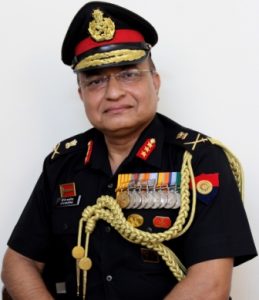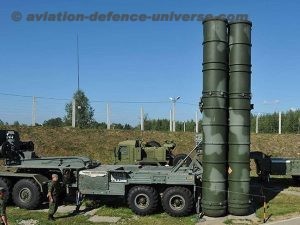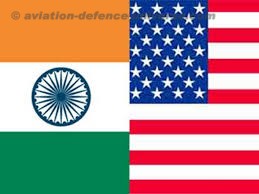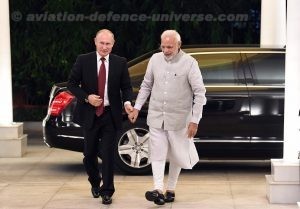- A much debated issue
By Lt. General VK Saxena (Retd.)

New Delhi. 05 April 2021. Ever since the Contract for 5 regiments of S – 400 has been inked between India and Russia , there has been a constant uproar in the US, trying to register its strong objections to such a purchase . Applications of sanctions through instruments like CAATSA (Countering America’s Adversary Through Sanctions Act) etc. are being wielded as threat-in-being. The entire issue of the so called sanctions and the much debated Yes or No about it is actually like the proverbial ‘Sword of Damocles’’. It threatens to fall, axing the Indo-US bonhomie that at present is trending at high pitch.
In trying to dissuade India from buying S-400 US has been quoting its apprehension regarding the loss of ‘electronic signatures’ of its high-tech equipment featuring niche technologies that has currently made its way into India .
US Apprehension & its analysis
Revisiting the US apprehension put out for the public eye will be an interesting journey. As stated, the US apprehension in the public domain is based on its fear of the loss of ‘electronic signatures’ of its high-tech equipment recently inducted into India.
The above gets a shot-in-the-arm by the fact that India will surely have an access to sensitive and encrypted information on high-tech equipment having signed the foundational agreements such as COMCASA (Communication and Information Security Memorandum of Understanding) and BECA (Basic Exchange and Cooperation Agreement).
Before the analysis, it is important to clarify, what sensitive equipment is being referred to by the US and what is so called ‘electronic signature. These are briefly enumerated. Ever since the Indo-US Defence Trade and Technology Initiative or DTTI – institutional platform for promoting to boost bilateral defence got traction riding on the wave of Make-in-India and later Atmanirbhar Bharat, there has been a steady flow of high-tech US platforms in the Indian defence Industry. The salient ones among these include the C-130s Super Hercules, P-81 Long Range Maritime Recce and Anti-Submarine helicopters , C-17 Globe master heavy transport aircrafts, AH 64 Attack Helicopters, CH -17 Chinook Heavy Lift helicopters, (NASAAMs, Sikorsky MH 60 R anti-submarine helicopters, Sea Guardian drones in near future) and more.
US apprehension has been that with the foundational Agreements as mentioned earlier being in place, one thing that is certain is that India will have the access to the high tech technology, encrypted information, geo-spatial intelligence etc. related to the above platforms. With that as given, there is every chance of its reaching the Russian hands with core-systems like S 400 in place.
A word about ‘electronic signatures’ .Very basically, when an aerial platform is under surveillance or tracking ( later implying ‘locked-on’ for engagement), a few or all of following parameters are registered by the sensor:-
- Location details in 4D – Azimuth, Range, Altitude, Time.
- RCS or Radar Cross Section. RCS is basically a measure of the detectability of an aerial vehicle. Higher the RCS, greater will be the electronic visibility of the vehicle at a given range and altitude envelope.
- Kind of stealth muscle of the target. This gets revealed as critical information of the range of frequencies over which the stealth capability of the aerial platform is effective.
- Jamming capability of the aerial target again judged by actual performance over own frequency spectrum it is able to jam in a typical SEAD (Suppression of Enemy Air Defence) operations.
- Prowess of its electronic warfare suit over the frequency continuum in disabling own sensors.
The package is called the ‘electronic signatures’ which the US proclaims is up for a possible compromise.

How true is this claim? To answer this poser will demand a brief look at the S 400 system which is a long range air defence and anti-missile system. The basic philosophy that drives the configuration of this system is here for your comsumption. The incoming threat (aircrafts, missiles etc.) are detected at the longest possible ranges by a series of Long Range Surveillance Radars (LRSRs). Once detected, these are passed on to such radars that can lock on the threat for engagement ( Multi-Function Radars or MFRs) and launch the missiles of the system to destroy the threat.
S-400is a very strong system, It has a pack of five types of LRSRs optimized for various altitudes and target types (aircrafts, ballistic missiles etc.). These cover a range from 400-600 km. The four interceptors (missiles) on board have ranges of 40, 120, 200-250 and 400 km extending the fire arm all the way. At the onset it is very much possible for the sensors of S-400 to detect much of the ‘electronic signatures’ of the aerial vehicles under surveillance, but the point is that S 400 is not a stand-alone system or a system which can be controlled by Russia post its induction into India.
Following points are stated as to how the system will get embedded in the air defence matrix of India.S-400 or for that matter any air defence system be it on land sea and air is a part of the centralised Air Defence Battle Management and Command and Control ( BMC2) System. In India the Indian Air Force in execution of its responsibility of the national air defence has provided a nation-wide air defence BMC2 system. It is called Integrated Air Command and Control System or IACCS and controls all air defence weapons, so much so, that no air defence weapon can operate unless cleared by IACCS. S-400 will be a part of IACCS and its sensors while serving the weapon per se, will be an asset of the IACCS.
The software muscle which controls the IACCS is 100% Indian designed with total IPR exclusivity in public defence domain. All data flow (including two-way sensor inputs), control instructions and fire-clearance will flow from IACCS right down to the weapon end. Nothing gets patched up independently on S- 400. In sum, while the ‘Indians’ will have every input of the so-called electronic signatures, it will not be possible for any outside agency to make inroads into an total Indian-design and controlled Software. Some other far-fetched thoughts of data leak from ‘embedded bugs’ etc. are not tenable as even a remote possibility. If that was possible, why only the S-400 sensors? There are scores of Russian sensors already serving in the air defence inventory of India for decades. The much touted American hue and cry is therefore UNSUBSTANTIATED.

Getting to the real reasons could be interesting. The first big reason of such unprecedented American resistance is to prevent funds inflow into the Russian defence and intelligence set up. In corroboration of the above assertion, it is relevant to note that the entire edifice of CAATSA rests on a single premise of sanctioning a person/entity which engages in a ‘significant transaction’ with the Russian defence and intelligence set up. 39000Crs/5.85 Bn USD for 5 regiments of S-400 is very much a ‘significant transaction’. The multiple reasons of US attempting to stymie the Russian defence and intelligence establishment is a vertical by itself that goes back into decades and Centuries. This is not attempted here.
The second reason for the US objection lies in the fear of loosing an opportunity of a ‘generation’ in making any significant dent in the air defence equipment profile of India. This is briefly enumerated:-For decades spanning the 80s and 90s the US firms mostly stood out from the Indian procurement scene due to two main reasons ; 1. The incompatibility between the Indian system of procurement and the US Foreign Military Sales (FMS) procedure 2. A total NO GO when it came to sharing technology.
While much of these changed with DTTI, Make-in-India and other instruments and a number of hi-tech US platforms got inducted into India , the air defence weapon sales still drew a near blank except for one odd NASAAMII deal whose future is also not certain owing to similar capabilities having been harnessed by the Indian domestic sector. While the US did offer the Patriot and THAAD systems during the evolution process, these didn’t have a chance when compared with the combat virtues of S-400 as regards range, altitude, effectiveness, SSKP and more.
Weapons like S-400 are not for few years . They are for generations. Say for the next 30-40 years the Indian BMD scene will be painted by S-400 standing shoulder-to-shoulder with Indian systems. The feeling of loss is therefore of a ‘generation of missed opportunity’ .This in nutshell justifies the great amount of uproar in the US about S -400.

How this is likely to play out? What about the Yes/No of the sanctions business? What are the stakes involved in the sanctions act? These are all verticles by themselves demanding an article space or two. May be the next one.
Be that as it may, the reader now knows the ‘fire’ beyond all the ‘smoke’ bellowing into the public domain and going by different names of US fury and frustration – CAATSA, sanctions and more.
(Lt Gen (Dr) V K Saxena is the former Director General of the Corps of Army Air Defence. He has been decorated three times by the President of India. Presently, he is the Distinguished Fellow at VIF. The General is a prolific writer who has authored five books and is regularly published by the Defence media of the country. He is also a regular at TV shows contributing on many a defence issues. The views in the article are solely the author’s. He can be contacted at editor.adu@gmail.com).
































































































































